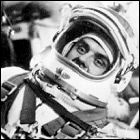 The first flight of the Soviet Union’s new manned space vehicle, Soyuz 1, lifts off from the Baikonur Cosmodrome. Though designed to accomodate a crew of three – and intended to be the answer to NASA’s Apollo command/service module in the ongoing race to reach the moon – the first Soyuz is flown by test pilot (and close friend of Yuri Gagarin) Vladimir Komarov. Though early plans for the mission involve a rendezvous and docking with a second Soyuz, only one vehicle is available for the mission, and it suffers a series of technical problems. Though aware of the faults in the Soyuz design, engineers have been pressured to put a manned Soyuz in orbit for political reasons.
The first flight of the Soviet Union’s new manned space vehicle, Soyuz 1, lifts off from the Baikonur Cosmodrome. Though designed to accomodate a crew of three – and intended to be the answer to NASA’s Apollo command/service module in the ongoing race to reach the moon – the first Soyuz is flown by test pilot (and close friend of Yuri Gagarin) Vladimir Komarov. Though early plans for the mission involve a rendezvous and docking with a second Soyuz, only one vehicle is available for the mission, and it suffers a series of technical problems. Though aware of the faults in the Soyuz design, engineers have been pressured to put a manned Soyuz in orbit for political reasons.

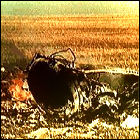 After a day in space aboard a spacecraft crawling with technical glitches, cosmonaut Vladimir Komarov orients the Soyuz 1 capsule for return to Earth. Though the vehicle survives reentry through Earth’s atmosphere, the main parachute fails to open, and the first Soyuz capsule returns to Earth at a speed of well over 100 miles per hour, killing Komarov instantly. The Soviet Union’s space program is stalled – much like the American Apollo program, postponed after the fatal Apollo 1 fire – well into 1968 as a result of the need to redesign Soyuz from the inside out.
After a day in space aboard a spacecraft crawling with technical glitches, cosmonaut Vladimir Komarov orients the Soyuz 1 capsule for return to Earth. Though the vehicle survives reentry through Earth’s atmosphere, the main parachute fails to open, and the first Soyuz capsule returns to Earth at a speed of well over 100 miles per hour, killing Komarov instantly. The Soviet Union’s space program is stalled – much like the American Apollo program, postponed after the fatal Apollo 1 fire – well into 1968 as a result of the need to redesign Soyuz from the inside out.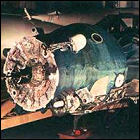 The Soviet Union resumes its manned space program with the launch of cosmonaut Georgy Beregovoy aboard the redesigned Soyuz 3 vehicle. The unmanned Soyuz 2 is launched the day before to serve as a docking target for Soyuz 3, but while the two vehicles pass close to each other, no docking is achieved. Beregovoy successfully returns to Earth – the first Soyuz cosmonaut to do so – after four days in orbit.
The Soviet Union resumes its manned space program with the launch of cosmonaut Georgy Beregovoy aboard the redesigned Soyuz 3 vehicle. The unmanned Soyuz 2 is launched the day before to serve as a docking target for Soyuz 3, but while the two vehicles pass close to each other, no docking is achieved. Beregovoy successfully returns to Earth – the first Soyuz cosmonaut to do so – after four days in orbit.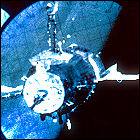 With only cosmonaut Vladimir Shatalov aboard, the Soviet Union launches Soyuz 4 into Earth orbit. Another manned vehicle, Soyuz 5, is launched the next day, and the two vehicles dock in orbit, the first docking of two manned spacecraft. Alexei Yeliseyev and Yevgeny Khrunov perform a spacewalk to leave Soyuz 5 and board Soyuz 4 for the return home (though the two capsules have primitive docking hardware, they do not have a docking tunnel or airlocks). Soyuz 4 makes a safe landing after two days in orbit – which is more than can be said for its sister ship.
With only cosmonaut Vladimir Shatalov aboard, the Soviet Union launches Soyuz 4 into Earth orbit. Another manned vehicle, Soyuz 5, is launched the next day, and the two vehicles dock in orbit, the first docking of two manned spacecraft. Alexei Yeliseyev and Yevgeny Khrunov perform a spacewalk to leave Soyuz 5 and board Soyuz 4 for the return home (though the two capsules have primitive docking hardware, they do not have a docking tunnel or airlocks). Soyuz 4 makes a safe landing after two days in orbit – which is more than can be said for its sister ship. The Soviet Union launches a three-man crew aboard Soyuz 5, which docks in orbit with the already-launched Soyuz 4 – the first two crewed spacecraft to accomplish this feat. The Soyuz 5 crew consists of cosmonauts Boris Volynov, Alexei Yeliseyev and Yevgeny Khrunov, but only Volynov makes the return journey aboard Soyuz 5, as his crewmates board Soyuz 4 via spacewalk. It’s probably just as well for them: after three days in orbit, Soyuz 5 begins its descent to Earth, but the failure of explosive bolts meant to separate the re-entry capsule from the rest of the vehicle fail. To maintain some semblence of a survivable aerodynamic profile, Volynov flies Soyuz 5 in nose-first – one of the riskiest re-entries in the history of human spaceflight, since the nose of the capsule is not covered by any heat shielding. The vehicle separates just before the stress of re-entry would have destroyed it, but then its parachutes fail to completely deploy, resulting in a punishingly jarring but non-fatal landing, hard enough to break Volynov’s teeth.
The Soviet Union launches a three-man crew aboard Soyuz 5, which docks in orbit with the already-launched Soyuz 4 – the first two crewed spacecraft to accomplish this feat. The Soyuz 5 crew consists of cosmonauts Boris Volynov, Alexei Yeliseyev and Yevgeny Khrunov, but only Volynov makes the return journey aboard Soyuz 5, as his crewmates board Soyuz 4 via spacewalk. It’s probably just as well for them: after three days in orbit, Soyuz 5 begins its descent to Earth, but the failure of explosive bolts meant to separate the re-entry capsule from the rest of the vehicle fail. To maintain some semblence of a survivable aerodynamic profile, Volynov flies Soyuz 5 in nose-first – one of the riskiest re-entries in the history of human spaceflight, since the nose of the capsule is not covered by any heat shielding. The vehicle separates just before the stress of re-entry would have destroyed it, but then its parachutes fail to completely deploy, resulting in a punishingly jarring but non-fatal landing, hard enough to break Volynov’s teeth.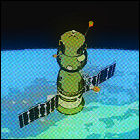 The Soviet Union launches the first Soyuz mission since the American moon landing, Soyuz 6. With Georgi Shonin and future Apollo-Soyuz crewmember Valery Kubasov aboard, Soyuz 6 is intended to “chase’ two other manned Soyuz capsules launched in the days ahead, filming them as they perform an orbital docking maneuver. When the rendezvous radar gear aboard all three Soyuz vehicles fail to function properly, the docking is aborted. Shonin and Kubasov return to Earth after nearly five days in space.
The Soviet Union launches the first Soyuz mission since the American moon landing, Soyuz 6. With Georgi Shonin and future Apollo-Soyuz crewmember Valery Kubasov aboard, Soyuz 6 is intended to “chase’ two other manned Soyuz capsules launched in the days ahead, filming them as they perform an orbital docking maneuver. When the rendezvous radar gear aboard all three Soyuz vehicles fail to function properly, the docking is aborted. Shonin and Kubasov return to Earth after nearly five days in space.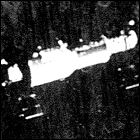 Salyut 1, the first orbiting space station in history is launched, unmanned, by the Soviet Union. With Salyut 1, the Soviet space program intends to vault ahead of the United States in a new space discipline (namely long stays in space and the study of human endurance in a zero-G environment), having lost the moon race. The first Salyut station will orbit Earth for less than a year.
Salyut 1, the first orbiting space station in history is launched, unmanned, by the Soviet Union. With Salyut 1, the Soviet space program intends to vault ahead of the United States in a new space discipline (namely long stays in space and the study of human endurance in a zero-G environment), having lost the moon race. The first Salyut station will orbit Earth for less than a year. The Soviet Union launches the Soyuz 10 mission, intended to become the first crew to occupy an Earth-orbiting space station. Flying a new modification of the Soyuz vehicle, fitted with a new system for docking to the Salyut 1 space station, are Vladimir Shatalov, Alexei Yeliseyev and Nikolai Rukavishnikov, but they won’t be the first space station crew in history: the Soyuz capsule fails to hard-dock to the station, making it impossible for them to enter. Soyuz 10 returns to Earth after two days, and even on the return journey the cosmonauts are sickened by toxic fumes in their environmental system. Salyut 1 remains in orbit, still unmanned.
The Soviet Union launches the Soyuz 10 mission, intended to become the first crew to occupy an Earth-orbiting space station. Flying a new modification of the Soyuz vehicle, fitted with a new system for docking to the Salyut 1 space station, are Vladimir Shatalov, Alexei Yeliseyev and Nikolai Rukavishnikov, but they won’t be the first space station crew in history: the Soyuz capsule fails to hard-dock to the station, making it impossible for them to enter. Soyuz 10 returns to Earth after two days, and even on the return journey the cosmonauts are sickened by toxic fumes in their environmental system. Salyut 1 remains in orbit, still unmanned. After a tuberculosis scare forces Soviet space officials to ground the mission’s original crew, the backup crew of Soyuz 11 lifts off to become the first occupants of a manned space station. Experiencing none of the difficulties that plagued the earlier Soyuz 10 attempt to dock with Salyut 1, the Soyuz 11 crew stays aboard Salyut for 22 days, a new record for a manned space mission.
After a tuberculosis scare forces Soviet space officials to ground the mission’s original crew, the backup crew of Soyuz 11 lifts off to become the first occupants of a manned space station. Experiencing none of the difficulties that plagued the earlier Soyuz 10 attempt to dock with Salyut 1, the Soyuz 11 crew stays aboard Salyut for 22 days, a new record for a manned space mission.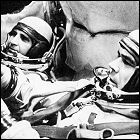 After two years of reorganization and rethinking, the Soviet manned space program resumes with the launch of Soyuz 12, carrying cosmonauts Vasili Lazarev and Oleg Makarov. Previously a three-seater, Soyuz has been redesigned following the Soyuz 11 tragedy: the vehicle now seats a crew of two, both wearing fully pressurized spacesuits. Originally intended to visit the Salyut 2 station, Soyuz 12 is only a two-day shakedown flight for the redesigned spacecraft (Salyut 2’s own technical problems have rendered it uninhabitable by a human crew).
After two years of reorganization and rethinking, the Soviet manned space program resumes with the launch of Soyuz 12, carrying cosmonauts Vasili Lazarev and Oleg Makarov. Previously a three-seater, Soyuz has been redesigned following the Soyuz 11 tragedy: the vehicle now seats a crew of two, both wearing fully pressurized spacesuits. Originally intended to visit the Salyut 2 station, Soyuz 12 is only a two-day shakedown flight for the redesigned spacecraft (Salyut 2’s own technical problems have rendered it uninhabitable by a human crew). Cosmonauts Pyotr Klimuk and Valentin Lebedev lift off aboard Soyuz 13, the second proving flight of the redesigned Soyuz spacecraft. Their eight-day-long stay in Earth orbit is a Soviet space program rarity: a flight devoted solely to scientific observations with no military objectives. Many of the science experiments were originally intended to be conducted on board the Salyut 1 space station. Much like the Skylab 4 crew, which is in orbit at the same time, the Soyuz 13 crew is able to observe Comet Kohoutek.
Cosmonauts Pyotr Klimuk and Valentin Lebedev lift off aboard Soyuz 13, the second proving flight of the redesigned Soyuz spacecraft. Their eight-day-long stay in Earth orbit is a Soviet space program rarity: a flight devoted solely to scientific observations with no military objectives. Many of the science experiments were originally intended to be conducted on board the Salyut 1 space station. Much like the Skylab 4 crew, which is in orbit at the same time, the Soyuz 13 crew is able to observe Comet Kohoutek. The Soviet Union launches the Soyuz 14 mission, sending cosmonauts Yuri Artyukhin and Pavel Popovich to embark on a two-week stay aboard the Salyut 3 military space station. Though some medical science experiments are performed at Salyut 3, the majority of the crew’s time is taken up with observations of the Earth’s surface, essentially making Salyut 3 the first manned military surveillance satellite. Before leaving, the crew of two offloads supplies so that the new Salyut 3 crew can stay for several months.
The Soviet Union launches the Soyuz 14 mission, sending cosmonauts Yuri Artyukhin and Pavel Popovich to embark on a two-week stay aboard the Salyut 3 military space station. Though some medical science experiments are performed at Salyut 3, the majority of the crew’s time is taken up with observations of the Earth’s surface, essentially making Salyut 3 the first manned military surveillance satellite. Before leaving, the crew of two offloads supplies so that the new Salyut 3 crew can stay for several months.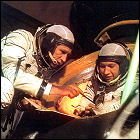 The Soviet space program continues with the launch of Soyuz 15, carrying cosmonauts Lev Dyomin and Gennadi Sarafanov. This is intended to be the second crew to occupy the Salyut 3 military space station, but spacecraft systems intended to automate the rendezvous and docking process fail. After manual dockings are attempted, the Soyuz vehicle is running low on fuel and the crew is recalled to Earth after only two days. (Trying to dodge questions about the nature of Salyut 3’s mission objectives, Soviet space authorities later claim that Soyuz 15 was never going to dock with the station.) No further crews are sent to board Salyut 3.
The Soviet space program continues with the launch of Soyuz 15, carrying cosmonauts Lev Dyomin and Gennadi Sarafanov. This is intended to be the second crew to occupy the Salyut 3 military space station, but spacecraft systems intended to automate the rendezvous and docking process fail. After manual dockings are attempted, the Soyuz vehicle is running low on fuel and the crew is recalled to Earth after only two days. (Trying to dodge questions about the nature of Salyut 3’s mission objectives, Soviet space authorities later claim that Soyuz 15 was never going to dock with the station.) No further crews are sent to board Salyut 3.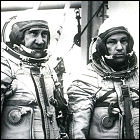 The Soviet Union launches Soyuz 16, a six-day manned space mission to test modifications to the Soyuz vehicle design ahead of
The Soviet Union launches Soyuz 16, a six-day manned space mission to test modifications to the Soyuz vehicle design ahead of 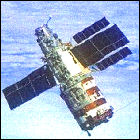 Soyuz 17 is launched by the Soviet Union, carring cosmonauts Alexei Gubarev and Georgi Grechko to the Salyut 4 space station. The two men move into the station for a month-long stay, breaking the previous Soviet space record, and proceed to conduct several science experiments. Discovering that the mirror of Salyut 4’s on-board telescope is warped, the crew resurfaces it in orbit and repairs the telescope. When Soyuz 17 returns to Earth, the crew is in for one of the bumpiest landings of the Soviet space program to date, landing in a blizzard with 45mph winds at ground level. Despite this, the vehicle lands safely and the crew is not injured.
Soyuz 17 is launched by the Soviet Union, carring cosmonauts Alexei Gubarev and Georgi Grechko to the Salyut 4 space station. The two men move into the station for a month-long stay, breaking the previous Soviet space record, and proceed to conduct several science experiments. Discovering that the mirror of Salyut 4’s on-board telescope is warped, the crew resurfaces it in orbit and repairs the telescope. When Soyuz 17 returns to Earth, the crew is in for one of the bumpiest landings of the Soviet space program to date, landing in a blizzard with 45mph winds at ground level. Despite this, the vehicle lands safely and the crew is not injured. The two-man crew selected to become the second group of occupants for the Soviet Union’s Salyut 4 space station nearly rockets into disaster. Interstage connectors, intended to open simultaneously to allow the third stage of the booster to carry the Soyuz spacecraft into orbit, fail to open on cue, leaving the third stage dragging the dead weight of the spent second stage, changing the trajectory of the entire vehicle. The Soyuz capsule carrying cosmonauts Vasili Lazarev and Oleg Makarov is blasted free, and the two men experience acceleration of 23 Gs as the capsule roars toward a bruisingly rough emergency landing. As if that’s not bad enough, the Soyuz capsule lands perilously close to the USSR’s border with China, and rescue crews spend over 24 hours looking for the crew. The usually secretive Soviet space agency reluctantly reveals details of the mission to NASA, with whom they are collaborating ahead of the historic Apollo-Soyuz joint launch.
The two-man crew selected to become the second group of occupants for the Soviet Union’s Salyut 4 space station nearly rockets into disaster. Interstage connectors, intended to open simultaneously to allow the third stage of the booster to carry the Soyuz spacecraft into orbit, fail to open on cue, leaving the third stage dragging the dead weight of the spent second stage, changing the trajectory of the entire vehicle. The Soyuz capsule carrying cosmonauts Vasili Lazarev and Oleg Makarov is blasted free, and the two men experience acceleration of 23 Gs as the capsule roars toward a bruisingly rough emergency landing. As if that’s not bad enough, the Soyuz capsule lands perilously close to the USSR’s border with China, and rescue crews spend over 24 hours looking for the crew. The usually secretive Soviet space agency reluctantly reveals details of the mission to NASA, with whom they are collaborating ahead of the historic Apollo-Soyuz joint launch.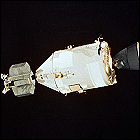 The final launch of an Apollo spacecraft takes place as the last Saturn rocket carries the American component of the Apollo-Soyuz Test Project into orbit. A cooperative international mission intended to see the Apollo capsule dock with a Soviet-launched Soyuz, the ASTP will be the last Apollo flight as the push toward the reusable Space Shuttle takes over NASA’s resources and planning. Aboard the Apollo command/service module are Commander Thomas Stafford, command module pilot Vance Brand, and docking module pilot Deke Slayton, the last of the seven original Mercury astronauts to reach space (heart conditions have prevented him from taking part in a mission until now). Soyuz 19, carrying cosmonauts Alexei Leonov and Valery Kubasov, lifts off a few hours earlier.
The final launch of an Apollo spacecraft takes place as the last Saturn rocket carries the American component of the Apollo-Soyuz Test Project into orbit. A cooperative international mission intended to see the Apollo capsule dock with a Soviet-launched Soyuz, the ASTP will be the last Apollo flight as the push toward the reusable Space Shuttle takes over NASA’s resources and planning. Aboard the Apollo command/service module are Commander Thomas Stafford, command module pilot Vance Brand, and docking module pilot Deke Slayton, the last of the seven original Mercury astronauts to reach space (heart conditions have prevented him from taking part in a mission until now). Soyuz 19, carrying cosmonauts Alexei Leonov and Valery Kubasov, lifts off a few hours earlier. 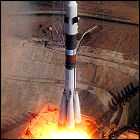 The Soviet Union launches cosmonauts Boris Volynov and Vitaly Zholobov aboard Soyuz 21, the first mission to the newly-orbited Salyut 5 military space station. Though a few scientific experiments are conducted, most of the crew’s activities involve military surveillance of Earth. The crew’s stay is intended to last as long as two months, though an emergency aboard the station will cut that stay short.
The Soviet Union launches cosmonauts Boris Volynov and Vitaly Zholobov aboard Soyuz 21, the first mission to the newly-orbited Salyut 5 military space station. Though a few scientific experiments are conducted, most of the crew’s activities involve military surveillance of Earth. The crew’s stay is intended to last as long as two months, though an emergency aboard the station will cut that stay short.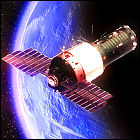 42 days into their stay aboard the military space station Salyut 5, Soviet cosmonauts Boris Volynov and Vitaly Zholobov report unusual odors in the station’s air. On the 49th day of their stay, the two men bundle into their Soyuz 21 capsule to return home on only 10 hours’ notice, an unprecedented event. Details of the causes of the emergency return remain closely guarded to this day, including the possibility of toxic gas escaping into the station’s atmosphere and causing one or both cosmonauts to suffer rapidly deteriorating health. Neither of them fly in space again after their return.
42 days into their stay aboard the military space station Salyut 5, Soviet cosmonauts Boris Volynov and Vitaly Zholobov report unusual odors in the station’s air. On the 49th day of their stay, the two men bundle into their Soyuz 21 capsule to return home on only 10 hours’ notice, an unprecedented event. Details of the causes of the emergency return remain closely guarded to this day, including the possibility of toxic gas escaping into the station’s atmosphere and causing one or both cosmonauts to suffer rapidly deteriorating health. Neither of them fly in space again after their return.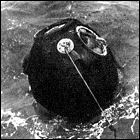 The Soviet Union’s Soyuz 23 mission lifts off from Baikonur Cosmodrome, intended for a stay of up to three months at the Salyut 5 space station. A serious malfunction of the automatic rendezvous gear forces an abort of the docking with the station, and cosmonauts Vyacheslav Zudov and Valery Rozhdestvensky are recalled to Earth, ending their orbit after just two days. But blizzard conditions near the landing site blow the Soyuz crew capsule off-course, resulting in the first-ever splashdown of the normally land-locked Soviet space program as Soyuz 23 plunges through the frozen surface of a lake. With their vehicle intact and functioning, the cosmonauts have to wait nine hours underwater for rescuers to bring the capsule to dry land.
The Soviet Union’s Soyuz 23 mission lifts off from Baikonur Cosmodrome, intended for a stay of up to three months at the Salyut 5 space station. A serious malfunction of the automatic rendezvous gear forces an abort of the docking with the station, and cosmonauts Vyacheslav Zudov and Valery Rozhdestvensky are recalled to Earth, ending their orbit after just two days. But blizzard conditions near the landing site blow the Soyuz crew capsule off-course, resulting in the first-ever splashdown of the normally land-locked Soviet space program as Soyuz 23 plunges through the frozen surface of a lake. With their vehicle intact and functioning, the cosmonauts have to wait nine hours underwater for rescuers to bring the capsule to dry land.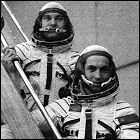 The Soviet Union launches Soyuz 25 into Earth orbit, with cosmonauts Vladimir Kovalyonok and Valery Ryumin set to become the first occupants of the new Salyut 6 space station. However, the crew is unable to successfully dock Soyuz 25 to Salyut 6, and after a fifth attempt to dock, the mission is aborted and the cosmonauts are recalled to Earth due to concerns about the remaining fuel in their vehicle. As a result, Soyuz 25 is the last all-rookie Soviet space crew until the 1990s.
The Soviet Union launches Soyuz 25 into Earth orbit, with cosmonauts Vladimir Kovalyonok and Valery Ryumin set to become the first occupants of the new Salyut 6 space station. However, the crew is unable to successfully dock Soyuz 25 to Salyut 6, and after a fifth attempt to dock, the mission is aborted and the cosmonauts are recalled to Earth due to concerns about the remaining fuel in their vehicle. As a result, Soyuz 25 is the last all-rookie Soviet space crew until the 1990s.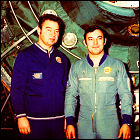 A two-man crew – cosmonauts Yuri Romanenko and Georgi Grechko – is launched aboard Soyuz 26 by the Soviet Union. The Soyuz capsule docks with the recently-launched Salyut 6 space station, and the crew takes up residence for over three months, setting a new space endurance record at 96 days. The Soyuz 27 crew visits in January and swaps vehicles with the station occupants, meaning that Romanenko and Grechko technically return to Earth aboard Soyuz 27 in March 1978. Ten days into the mission, the first Soviet spacewalk since 1969 is undertaken to examine the forward docking hatch of Salyut 6, with which the previous mission failed to connect. This spacewalk was the first outing of the Soviet-made Orlan spacesuit, a design still in use on the International Space Station in the 21st century.
A two-man crew – cosmonauts Yuri Romanenko and Georgi Grechko – is launched aboard Soyuz 26 by the Soviet Union. The Soyuz capsule docks with the recently-launched Salyut 6 space station, and the crew takes up residence for over three months, setting a new space endurance record at 96 days. The Soyuz 27 crew visits in January and swaps vehicles with the station occupants, meaning that Romanenko and Grechko technically return to Earth aboard Soyuz 27 in March 1978. Ten days into the mission, the first Soviet spacewalk since 1969 is undertaken to examine the forward docking hatch of Salyut 6, with which the previous mission failed to connect. This spacewalk was the first outing of the Soviet-made Orlan spacesuit, a design still in use on the International Space Station in the 21st century.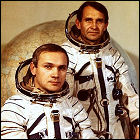 The Soviet Union launches Soyuz 27 on a mission to the Salyut 6 space station – the first instance of three vehicles being docked together in space. Cosmonauts Vladimir Dzhanibekov and Oleg Makarov spend six days with the crew of Soyuz 26 board the station, although Dzhanibekov and Makarov swap capsules with the station crew, leaving the newer vehicle at the station for their eventual return. The crew of Soyuz 27 is in space for less than a week, but their spacecraft remains in orbit, connected to Salyut, for over two months.
The Soviet Union launches Soyuz 27 on a mission to the Salyut 6 space station – the first instance of three vehicles being docked together in space. Cosmonauts Vladimir Dzhanibekov and Oleg Makarov spend six days with the crew of Soyuz 26 board the station, although Dzhanibekov and Makarov swap capsules with the station crew, leaving the newer vehicle at the station for their eventual return. The crew of Soyuz 27 is in space for less than a week, but their spacecraft remains in orbit, connected to Salyut, for over two months.